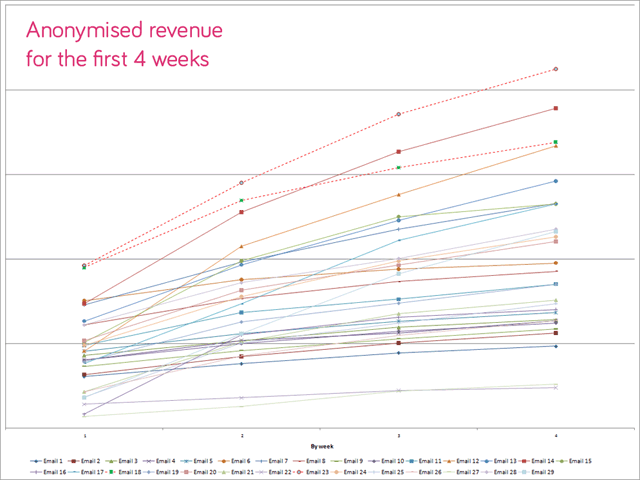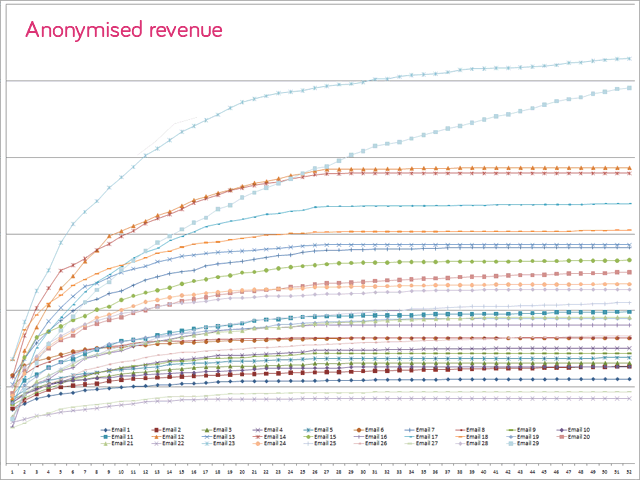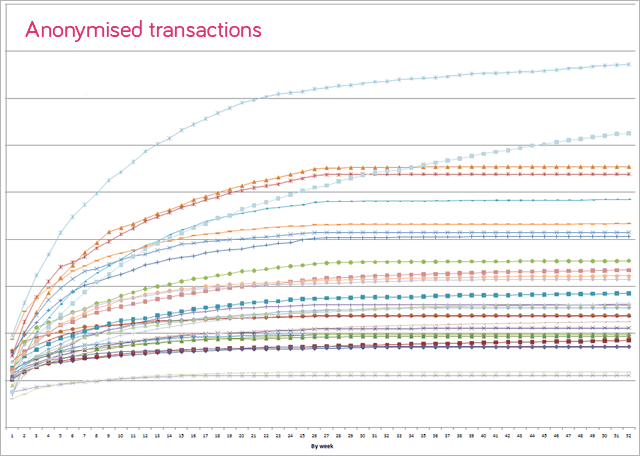Times are tough, marketing budgets are being squeezed, and we’re all being asked to do more with less. It’s imperative therefore that we are able to account for every penny spent and more than ever show the return on investment for our marketing budgets. This post shows how to make your email marketing even more accountable.
By simply tracking your email campaigns for a longer period you can show that your email marketing is returning more than initially thought.
Tracking your emails for more than a week or two might sound like hard work. And it is. But the rewards can far outweigh any inconvenience.
Why bother to track your emails?
Why? Because it gives an insight into how the return on investment increases over time the longer the email is tracked. For instance, in this case, the results of tracking an email for 52 weeks will be presented.
Study
In this activity, the broad behaviour/trends of email derived revenue and transactions were studied and tracked from initial send to 1 year post-send.
The Methodology & Execution
Using an Excel spreadsheet combined with tracking from Google Analytics, the revenue & transactional returns were charted from each email campaign individually, on a weekly basis.
Material
This study was comprised of 28 emails, with a variety of subject matters and themes including newsletters, ‘classic’ product launches and seasonal range launches, general interest and non-sales communications (such as quizzes, customer surveys and charity promotions).
Audience
The audience were mostly 50+ years old.
Timeframe
From the email send to a 52 week period (and beyond).
Results
Steep start = high long-term value
Returns start to flatten from week 20
Little to no additional income returned beyond week 26
Analysis
The expected outcome of this project was to get value in terms of insight, rather than monetary return, helping to make educated decisions on future email marketing based on the results.
Other key findings were:
- 80% of the total revenue contribution has been received by week 4.
- 90% of the total year 1 revenue has been received by week 10-11.
- 97% revenue contribution made by week 20.
- The 52 weeks’ sales value could be forecast – with some level of confidence – at week 4.
- Beyond week 26 the majority of contribution has been made.
- Emails not pushing generic sales have longer periods of income contribution.
- Emails pushing product sales return revenue over a shorter period compared with informational non-sales emails
- Non-sales type emails continue to deliver good levels of revenue way beyond week 10
(i.e. good, slow-burn campaigns that deliver incremental income over the longer-period) - Emails pushing specific new range sales have longer periods of income contribution
- Week 1’s income does not indicate how an email will perform in the medium-term!
You need to track to week 4 at a minimum
Key Takeaways
- Track emails beyond 4 weeks because users keep going back to their emails which in turn return transactions.
- Analyse emails to find those which give high traction over time, look for patterns.
- Forecast future emails to aid planning when you know transactional results from past email sends.
- ROI for an email send should not just be limited to 1-2 weeks of data. Such a short timeframe does not report the true value of your email.
- Recipients appear to use the email as a form of bookmark, similar to that in a web browser, using it to access the website and purchase online repeatedly, rather than going to the website directly. Not something we would have predicted or known to explore further without this piece of research.
- Insight such as this means emails can be used tactically to fill peaks & troughs in sales, build loyalty, push brochure launches etc.
- Don’t judge success by 4 weeks or less, though at this stage we can be near certain that we’ve seen 80% of total revenue, and can forecast the rest.
Conclusion
This research has provided fascinating insight into email marketing and the returns it offers in the long term. It demonstrates why tracking emails is vital, and specifically shows the value of tracking them on an ongoing basis. This tracking also serves to give the client a dashboard view of results, providing them with a tool for internal buy-in and a profile of email marketing that can be used to share knowledge within the wider team.
Weekly fluctuations in these emails will continue to be studied as the insight is invaluable in providing our client with accurate forecasts and shaping our email marketing service in the future.
Note: This research is based on a specific audience type and may not be directly transferable to other audiences.



